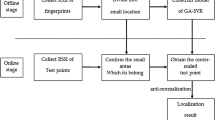Abstract
Through UWB positioning technology, accurate positioning in the house can be achieved. However, the obstruction of indoor houses leads to the decrease of positioning accuracy, and UWB can’t judge whether there is signal interference when collecting data. Therefore, judging whether there is signal interference is the key and difficult point of UWB accurate positioning. In order to judge which data are collected under the interference of signals and which data are collected without interference of signals, The fast and effective programming tool by Python to deal with pretreatment problems of data set, and by way of the effective algorithm based on support vector machine, establishes a binary classification prediction model to judge whether the collected data have interference or not. Ultimately, 486 samples data sets were collected for training by the algorithm, and 162 samples data sets were used to test whether there was any interference to the signal. Six prediction methods, such as k-nearest neighbor algorithm, light gradient boosting machine, decision tree, naive bayes, logistic regression, and neural network, were used for comparison with support vector machine algorithm, and the results were visualized by Python and other tools. Finally, the F1-score, recall, accuracy, and AUC of the prediction outcomes of support vector machine model were the highest, and the model had a high classification. Through the prediction of the data set with or without interference, we can further use the data set to select an appropriate algorithm to predict the coordinate of target points.
Access this chapter
Tax calculation will be finalised at checkout
Purchases are for personal use only
Similar content being viewed by others
References
Zhang, D., Niu, R., Liao, C.: Design of indoor positioning system. Sci. Technol. Innov. (28), 7–9 (2021)
Yang, G., Zhu, S., Li, Q., Zhao, K., Zhao, J., Guo, J.: An indoor cooperative positioning algorithm for firefighters based on UWB. Comput. Eng. Appl. 58(04), 106–117 (2022)
Nan, L., Bing, L.: 3D positioning and optimal filtering method based on UWB. J. Hebei Univ. (Nat. Sci. Ed.) 41(03), 329–336 (2021)
Liu, Q., Gao, C., Shang, R.: Analysis of the influence of linearization error on the positioning accuracy of UWB system. Surveying Mapp. Eng. 30(03) (2021)
Yanan, D., Zhang, X., Xu, L.: Overview of indoor positioning technology based on UWB. Intell. Comput. Appl. 9(05), 91–94 (2019)
Huan, L., Shitong, W.: Multi-observation sample binary classification algorithm based on support vector machine. J. Intell. Syst. 9(04), 392–400 (2014)
Chen, Y., Jiqing, Q., Wen**g, T., Ying, Z., Kexue, S.: Design and implementation of indoor positioning system based on LSTM. Electron. Meas. Technol. 44(19), 161–166 (2021)
Chao, W., Lei, Z., Chang, K.: Research on RFID indoor location algorithm based on BP neural network. Comput. Simul. 32(07), 323–326 (2015)
Haiyan, W., Jianhui, L., Fenglei, Y.: Review of support vector machine theory and algorithm. Comput. Appl. Res. 31(05), 1281–1286 (2014)
Hoang, M.T., Yuen, B., Dong, X., et al.: Recurrent neural networks for accurate RSSI indoor localization. IEEE Internet Things J. 6(6), 10639–10651 (2019)
Zhu, Y., Luo, H., Zhao, F., et al.: Indoor/outdoor switching detection using multisensor DenseNetand LSTM. IEEE Internet Things J. 8(3), 1544–1556 (2020)
Rigopoulos, G.: Assessment and feedback as predictors for student satisfaction in UK higher education. Int. J. Mod. Educ. Comput. Sci. (IJMECS) 14(5), 1–9 (2022). https://doi.org/10.5815/ijmecs.2022.05.01
Ojo, J.S., Ijomah, C.K., Akinpelu, S.B.: Artificial neural networks for earth-space link applications: a prediction approach and inter-comparison of rain-influenced attenuation models. Int. J. Intell. Syst. Appl. (IJISA) 14(5), 47–58 (2022). https://doi.org/10.5815/ijisa.2022.05.05
Dhaliwal, P., Sharma, S., Chauhan, L.: Detailed study of wine dataset and its optimization. Int. J. Intell. Syst. Appl. (IJISA) 14(5), 35–46 (2022). https://doi.org/10.5815/ijisa.2022.05.04
Yang, H., Yang, H., Wang, J., Zhou, K., Cai, B.: RON loss prediction based on model of light gradient boosting machine. In: Hu, Z., Gavriushin, S., Petoukhov, S., He, M. (eds.) Advances in Intelligent Systems, Computer Science and Digital Economics III. LNCS, vol. 121, pp. 187–199. Springer, Cham (2022). https://doi.org/10.1007/978-3-030-97057-4_17
Acknowledgment
This paper was supported by the following projects:
1) Wuhan Polytechnic University School-level Teaching and Research Project (Grant No. 2020Y20), Hubei Postgraduate Workstation Project (Grant No. 8021341), Ministry of Education Industry-University Cooperation Project (Grant No. 202101130033).
2) Name of scientific research project established by the university: multi-objective intelligent optimization algorithm and its application in pork storage and transportation, No. 2020Y20.
3) The name of the school established teaching and research project: the construction of artificial intelligence technology innovation talent training program, No. XM2021015.
4) Name of school enterprise cooperation project: Research on Application of Artificial Intelligence and Big Data Analysis System, No.: whpu-2021-kJ-762 (8021341).
5) Name of school enterprise cooperation project: production and operation information management platform for Qianjiang shrimp rice supply chain traceability, No.: whpu-2021-kJ-1145.
6) Name of school enterprise cooperation project: R&D of packaging equipment for small granular materials or powder materials “project, No.: whpu-2022-kJ-1586.
7) Hubei Provincial Teaching and Research Project Name: Research on Assessment and Evaluation of Higher Mathematics Teaching Process after the Cancellation of the Qingkao System, No.: 2018368.
Author information
Authors and Affiliations
Corresponding author
Editor information
Editors and Affiliations
Rights and permissions
Copyright information
© 2023 The Author(s), under exclusive license to Springer Nature Switzerland AG
About this paper
Cite this paper
Yang, H., Yang, H., Wang, J., Lin, D., Zhou, K. (2023). Prediction of UWB Positioning Coordinates with or Without Interference Based on SVM. In: Hu, Z., Wang, Y., He, M. (eds) Advances in Intelligent Systems, Computer Science and Digital Economics IV. CSDEIS 2022. Lecture Notes on Data Engineering and Communications Technologies, vol 158. Springer, Cham. https://doi.org/10.1007/978-3-031-24475-9_8
Download citation
DOI: https://doi.org/10.1007/978-3-031-24475-9_8
Published:
Publisher Name: Springer, Cham
Print ISBN: 978-3-031-24474-2
Online ISBN: 978-3-031-24475-9
eBook Packages: Intelligent Technologies and RoboticsIntelligent Technologies and Robotics (R0)




